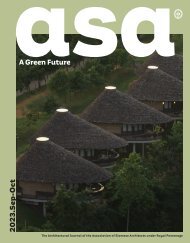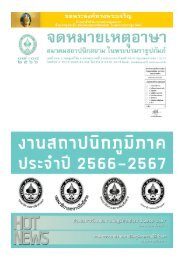ASA JOURNAL 14/2023
Create successful ePaper yourself
Turn your PDF publications into a flip-book with our unique Google optimized e-Paper software.
30<br />
around<br />
Curator Presentation on<br />
“The Story behind Infinity Ground—Thailand and<br />
Taiwan Contemporary Architecture Exhibition”<br />
and Infinity Ground Dialogue<br />
July 18, <strong>2023</strong><br />
กุลธิดา ทรงกิตติภักดี และ Jenchieh (Jerry) Hung สอง<br />
สถาปนิกผู้ก่อตั้งบริษัท HAS ซึ่งรับหน้าที่เป็นภัณฑารักษ์<br />
หลักของนิทรรศการในครั้งนี้ ได้กล่าวถึงแนวความคิด<br />
เบื้องต้นเมื่อได้รับโจทย์ให้การออกแบบงานนิทรรศการ<br />
Infinity Ground โดยทางทีมผู้ออกแบบได้รับแรงบันดาลใจ<br />
มาจากแสงที่ส่องผ่านช่องแสงของหลังคา BACC ลงสู ่พื ้น<br />
ชั้นใต้ดิน ซึ่งเป็นพื้นที่จัดนิทรรศการ ด้วยเห็นว่าเป็นลักษณะ<br />
ร่วมที่พบได้บ่อยทั้งในงานสถาปัตยกรรมไทยและไต้หวัน<br />
ตัวอย่างเช่น ในโบสถ์ของวัดศรีชุม จังหวัดสุโขทัย และงาน<br />
สถาปัตยกรรมอีกหลายๆ แห่งในไต้หวัน ซึ ่ง Jerry ได้ตั้ง<br />
ข้อสังเกตถึง “ผืนดิน” ซึ่งเป็นส่วนเชื่อมโยงและประสานกัน<br />
ระหว่างทุกสิ่งบนโลก และได้ศึกษาเพิ่มเติมถึงประวัติศาสตร์<br />
ด้านธรณีวิทยาของเปลือกโลกจากหนังสือ The Origin of<br />
Continents and Oceans เขียนโดย นักธรณีวิทยาชาว<br />
เยอรมัน Alfred Lothar Wegener ผู้เขียนได้อธิบายไว้ว่า<br />
“ในอดีต โลกเคยรวมตัวกันเป็นมหาทวีป Pangea ล้อมรอบ<br />
ด้วยผืนน้ำาของ Panthalassa ต่อมาได้เคลื่อนที่แตกออกเป็น<br />
7 ทวีป 5 มหาสมุทรอย่างที่เป็นในปัจจุบัน” ทีมผู้ออกแบบ<br />
จึงได้นำาแนวความคิดนี้มาปรับใช้กับการออกแบบนิทรรศการ<br />
เพื่อคงไว้ซึ่งมุมมองของ “การเลื่อนไหล” และ “การรวมตัว”<br />
ของเปลือกโลก<br />
ทางทีมภัณฑารักษ์จึงได้แบ่งการนำาเสนอสถาปัตยกรรม<br />
ร่วมสมัยของไทยและไต้หวันออกเป็น 2 หมวดหลัก<br />
หมวดแรกกล่าวถึง “การแลกเปลี่ยนบนผืนดิน” (Ground<br />
Exchanges) โดยนำาเสนอตัวอย่างผลงานสถาปัตยกรรม<br />
ทั้งไทยและไต้หวันที่ประกอบขึ้นจาก การอยู่ร่วมกัน<br />
(Togetherness) ความศักดิ์สิทธิ์ (Ritual) ลักษณะพื้นถิ่น<br />
(Native) และการแทรกซึม (Porosity) แสดงให้เห็นถึง<br />
ทิศทางการอยู่ร่วมกันระหว่างสถาปัตยกรรมสมัยใหม่กับ<br />
ผืนดินในอนาคต หมวดที่สองแสดงตัวอย่างผลงานที่สื่อถึง<br />
“ความรู้สึกจากผืนดิน” (Feeling Grounds) โดยยกตัวอย่าง<br />
งานที่ก่อให้เกิดความเอื้อเฟื้อและเห็นอกเห็นใจผืนดิน<br />
เกิดเป็นความพิเศษ (Extra Ordinary) การหวนถึง<br />
รากเหง้า (Nostalgia) การประยุกต์ให้เข้ากับบริบท<br />
พื้นถิ่น (Vernacular) และความเชื่อมโยงแบบไร้ขอบเขต<br />
(Boundaryless) องค์ประกอบเหล่านี้เป็นสิ่งที่เชื่อมโยง<br />
สถาปัตยกรรมร่วมสมัยของไทยและไต้หวันเข้าด้วยกัน<br />
เสมือนกับชื่อของนิทรรศการ Infinity Ground—Thailand<br />
and Taiwan Contemporary Architecture<br />
Kulthida Songkittipakdee and Jenchieh (Jerry)<br />
Hung, the two founding principals of HAS alse act<br />
as the chief curator of this exhibition, discussed the<br />
initial concept of the exhibition design. HAS was<br />
initially inspired by the light that passes through<br />
the skylight of the BACC’s roof and illuminates the<br />
exhibition space on the basement level. The design<br />
team saw this as a common phenomenon in both<br />
Thai and Taiwanese architecture, such as in the<br />
church of Wat Si Chum, Sukhothai Province, and<br />
many other architectural works in Taiwan, where<br />
Jerry has noted “the land,” which is the common<br />
ground, connection, and cohesion between all<br />
things on earth. HAS also studied the geological<br />
history of the earth’s crust from the book The Origin<br />
of Continents and Oceans by German geologist<br />
Alfred Lothar Wegener, which states: “In the past,<br />
the earth was formed as a supercontinent, Pangea,<br />
surrounded by the waters of Panthalassa, and<br />
then split into the seven continents and five oceans<br />
that exist today”.<br />
Therefore, HAS has utilized this concept to create<br />
an exhibition that illustrates the perspectives of<br />
“Sliding” and “Agglomeration” of the earth’s crust.<br />
The curatorial team divides the presentation of<br />
contemporary Thai and Taiwanese architecture<br />
into two primary categories. “Ground Exchanges”<br />
showcases examples of Thai and Taiwanese<br />
architecture that incorporate Togetherness, Ritual,<br />
Native, and Porosity. It indicates the direction of<br />
coexistence between contemporary architecture<br />
and the earth of the future. As Extra Ordinary,<br />
Nostalgia, Vernacular, and Boundaryless, the<br />
second section, “Feeling Grounds,” presents a<br />
collection of works that inspire benevolence and<br />
sympathy for the earth. As suggested by the title of<br />
the exhibition, Infinity Ground: Thailand and Taiwan<br />
Contemporary Architecture, these elements are<br />
what connect Thai and Taiwanese contemporary<br />
architecture.


















